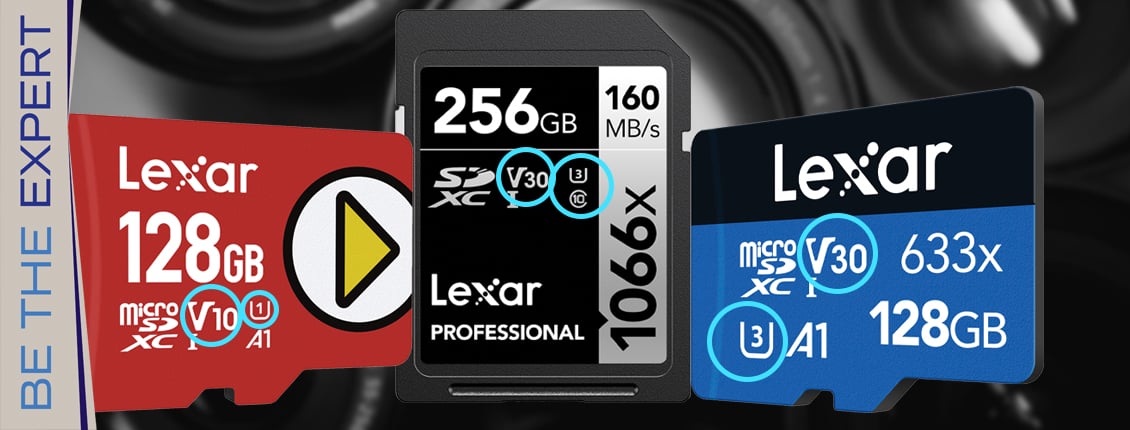
The Basics of SD Cards and SD Speed Class
A Secure Digital (SD) card is a tiny flash memory card designed for high-capacity memory and various portable devices. These include car navigation systems, cellular phones, e-books, PDAs, smartphones, digital cameras, music players, digital video camcorders, and personal computers.
SD cards are used to save digital photos or videos. Most people are familiar with SD cards and how they work. However, do your customers know how to select the proper SD card for their needs when there are a variety to choose from? Let’s take a deep dive into SD cards, SD speed class, how they work, and their applications.
The 4 Standards for Capacity
There are 2 essential specifications to identify SD cards: “capacity” and “writing speed.” The capacity is like a bucket. The larger the bucket, the more water you can put in. So, the larger the capacity, the more data you can save. And the write speed is like a water pipe for watering. The faster the write speed (the thicker the pipe diameter), the quicker the water can be filled into the bucket.
Secure Digital card technology includes the following:
• SD Standard Capacity: capacities for SDSC cards range from 128 megabytes to 2 GB. The default format for these cards is FAT16. (The File Allocation Table [FAT] is a file system created by Microsoft in 1977 and is still used today as the preferred file system for floppy drive media and portable, high capacity storage devices like flash drives and other solid-state memory devices like SD cards.)
• SD High Capacity: based on the SDA 2.0 specification, capacities for SDHC cards range from 2 GB to 32 GB. The default format for these cards is FAT32.
• SD eXtended Capacity: based on the SDA 3.0 specification, capacities for SDXC range from 32 GB to 2 terabytes. The default format for these cards is exFAT (Extended FAT).
• SDXC standard: capacities for SDXC range from a 2 TB to a 128 TB SDUC memory card using the exFAT file system. These are newer and less common.
What Are Speed Classes?
Not all SD cards offer the same speeds. The type of speed class matters for some tasks more than others. A professional photographer taking photos in a rapid sequence on a DSLR camera and saving them in a high-resolution RAW format will want the fastest SD card available. This allows the camera to save images as quickly as possible. A fast SD card is also important to record high-resolution video and save it directly to the SD card. If someone is leisurely taking photos on a regular camera, having an SD card with the fastest speed isn’t as important.
Manufacturers use “speed classes” to measure a SD card’s speed. The SD Association that defines the SD card standard doesn’t define the exact speeds associated with these classes, but they do provide guidelines.
Speed Classes
There are 4 different speed classes: 10 (10MB/sec read/write speed), 6 (6MB/sec), 4 (4MB/sec), and 2 (2MB/sec). Class 10 is the fastest, suitable for “full HD video recording” and “HD still consecutive recording.” Class 2 is the slowest, suitable for standard definition video recording. Classes 4 and 6 are both considered suitable for high-definition video recording.
Ultra-High-Speed Classes
There are also 2 Ultra High Speed (UHS) classes: 1 (10MB/sec read/write speed) and 3 (30MB/sec). These markers are mainly intended for devices designed for professional use, but they’re also found on most of today’s SD cards.
Video Speed Classes
Video Speed classes include V90 (which supports up to 8K video recording), V60 (4K recording), V30 (HD/Full HD video), and V10 and V6 (standard video).
Your customers will probably be okay with a class 4 or 6 SD card for typical use in a digital camera, smartphone, or tablet. Class 10 cards are ideal if they’re shooting high-resolution videos or RAW photos. Class 2 cards are a bit dated and slow so the best use for them would be on a cheap digital camera.

Physical Size
SD cards also come in different sizes. There are standard SD cards, miniSD cards, and microSD cards.
Standard SD cards are the largest, but still only measure 32 x 24 x 2.1 mm and weigh just 2 grams. Most consumer digital cameras for sale today still use standard SD cards. They have the familiar “cut corner” design.
miniSD cards are the least common size and are smaller than standard SD cards, measuring 21.5 x 20 x 1.4 mm and weighing about 0.8 grams. These cards were designed to be especially small for mobile phones, but now we have an even smaller size—microSD.
microSD cards are the smallest size of SD card, measuring 15 x 11 x 1 mm and weighing just 0.25 grams. These cards are used in most cell phones, smartphones, and drones that support SD cards. They’re also used in tablets and other such devices.
Choosing a size isn’t hard. SD cards can only fit into matching slots. However, there are adapters that allow for a smaller SD card to be plugged into a larger slot.

The Bottom Line for Choosing an SD Card
Ensure your customers check the product’s user guide and specs before buying an SD card. It might seem obvious, but that’s the best way to figure out which card is compatible, especially if the device (such as a 4K camcorder) has specific requirements.
Choosing the right SD card for a device is important for ensuring the best performance out of a device. A card too small could fill up and leave the user without any free space when they need it most. A card too slow could cause a device to choke when attempting to write files and potentially cause those files to be lost forever. If your customer knows what their device needs, and they need, they can find the right card with the right SD speed class easily.
